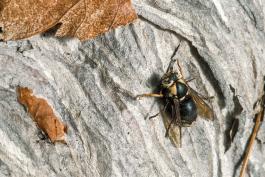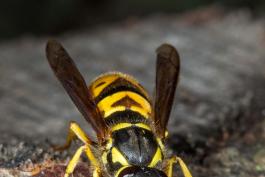Five winged and wingless, stinging and stingless wasps to Xplor (and one to watch out for)
Sure, some wasps can put the sting on summer fun. But the truth is, Missouri’s wasps aren’t out to hurt you. Many don’t even sting, and those that do are only trying to protect their nests. Most kinds of wasps are among our best friends in the natural world. They help pollinate our wildflowers and food, and they control other bugs that bug us like crop pests. They also serve as prey for birds like the summer tanager, which catches wasps to feed its babies. Amazing, right?!
Once you know what to look for, how to approach them, and what to expect, wasp-awareness can go from summer worry to summer wonder.
Let’s take a look at five wasps you’re likely to see this summer — and one to watch out for.
Can it Hurt Me?
Sometimes yes, sometimes no. Use Xplor’s handy sting pain scale to judge how closely you should watch a wasp.
Giant Ichneumon
Say “ick-new-mun” when you see this wasp. It can’t sting you, but the female uses her long, hollow, needlelike “tail” to deposit eggs near the grubs of wood-chomping wasps hiding under the bark. When the eggs hatch, the ichneumon larvae devour the grubs, and continue their life cycle.
What to Xplor for: A wasp with a long, thin “tail” creeping along a stump or tree. Every so often, she’ll curve down her slim tail and thread it into the wood.
Velvet Ant
The females of this wasp lack wings and look like large, furry, red-and-black ants. That’s no surprise since wasps, ants, and bees are members of the same group of insects. Velvet ants aren’t aggressive, but if you pick one up, you’ll find out why it’s also called “cow killer.”
What to Xplor for: This is your chance to watch two kinds of wasps at the same time. While you’re in an open, sandy area where cicada killers live, keep an eye out for the female velvet ant. When she finds a cicada killer nest, she’ll dig in and lay her eggs in the nursery cells. Can you guess what happens when her eggs hatch? That’s right, the velvet ant larvae will eat the cicada killer grubs. You could even call a velvet ant a cicada killer killer.
Cicada Killer
Only the females of these big, groundnesting wasps can sting, and — unless you try to handle them — they only attack dog-day cicadas. They stock their nests with two cicadas per cell.
What to Xplor for: In open, sandy areas, a mound of loose dirt with a shallow furrow marks a tunnel entrance. It’s fun to watch these wasps drag big, clunky cicadas into their nests.
Paper Wasp
This familiar wasp likes to nest around houses and buildings. It pollinates our wildflowers and food as it searches for nectar. It also collects caterpillars to feed its young, helping to control crop pests. It isn’t too aggressive — unless you reach for its nest. (But if you’re careful, you can generally avoid getting stung by this wasp.)
What to Xplor for: A wasp carrying a caterpillar back to a tan, papery layer of honeycomb cells hanging by a single stalk from a doorway or an eave.
Bald-Faced Hornet
These large black-and-white wasps pollinate wildflowers and food, and they catch insects to chew up and feed their young. If you get too close to their big, papery nests, they’ll sting you, but if you keep your distance, they won’t bug you.
What to Xplor for: A large, urn-shaped gray nest hanging in a hedgerow or up in a tree.
Yellowjacket
If there were a prize for homeland defense, this wasp would win it. It looks and acts like an easy-going honeybee, always searching for something sweet to eat. But if you accidentally run into its nest, it will sting you repeatedly.
What to watch out for: Yellowjackets usually make their large, papery nests underground, so they’re hard to spot. To detect a nest before you step on it, keep an eye out for slim, shiny, yellow-and-black wasps that fly quickly in a straight line. If you can see where they go into the ground, you’ll know to avoid that location.
To learn more about Missouri’s buzziest insects, visit mdc.mo.gov/field-guide.












Also In This Issue

And More...
This Issue's Staff
Les Fortenberry
Karen Hudson
Angie Daly Morfeld
Noppadol Paothong
Marci Porter
Mark Raithel
Laura Scheuler
Matt Seek
David Stonner
Nichole LeClair Terrill
Stephanie Thurber
Cliff White






















